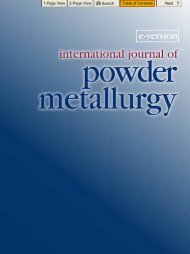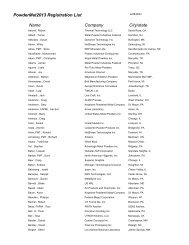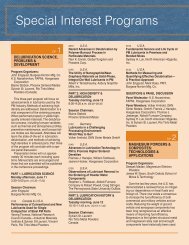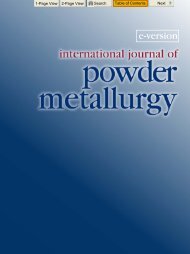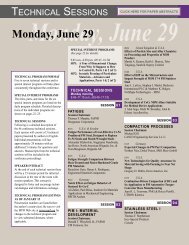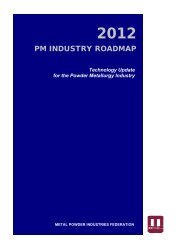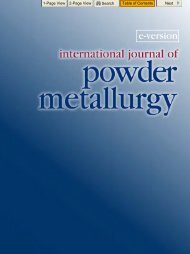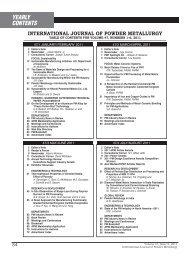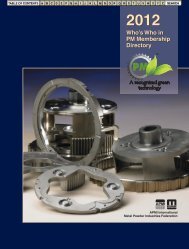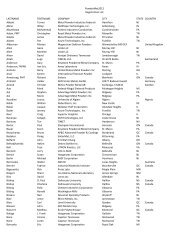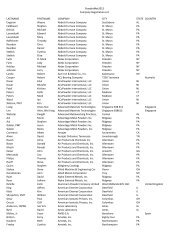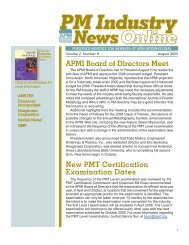E-IJPM: Vol. 44/4 - MPIF
E-IJPM: Vol. 44/4 - MPIF
E-IJPM: Vol. 44/4 - MPIF
Create successful ePaper yourself
Turn your PDF publications into a flip-book with our unique Google optimized e-Paper software.
STATE OF THE PM INDUSTRY IN NORTH AMERICA—2008<br />
52<br />
Figure 5. PM<br />
acquisitions<br />
since 1990<br />
TECHNOLOGY TRENDS<br />
Faced with macroeconomic and marketplace<br />
challenges, the PM industry continues to invest in<br />
new technology. Developments in metal powders,<br />
equipment, and processes are leading the way to<br />
higher-performance materials and new applications.<br />
Metal powder suppliers are developing new<br />
materials to achieve higher densities and improved<br />
properties. One manufacturer is promoting a<br />
material to achieve a density of 7.5 g/cm 3 by single<br />
pressing and sintering. The company has completed<br />
a project on surface densification of gears to<br />
pore-free density with a core density of 7.5 g/cm 3 .<br />
A PM parts maker has improved its surface-densification<br />
technology from single-level parts to complex<br />
multilevel gears and sprockets. Another<br />
powder maker has developed a new material that<br />
increases the fatigue limit of powder-forged connecting<br />
rods by 30 percent.<br />
Soft magnetic composite powders are finding<br />
application in new three-dimensional (3D) designs<br />
for electrical applications.<br />
While copper-powder usage has declined for<br />
traditional PM applications, thermal management<br />
and bioscience markets offer attractive growth<br />
opportunities. Copper’s antimicrobial properties<br />
could open up new applications in healthcare.<br />
Compacting-press makers are developing new<br />
technology. Some examples are presses offering<br />
up to 11 levels, enabling more net-shape parts,<br />
tonnages up to 2,450 mt (2,700 st), hybrid servo<br />
systems, and new warm-compaction heating and<br />
delivery systems.<br />
<strong>MPIF</strong> and the PM industry have been investing<br />
in new technology through the <strong>MPIF</strong> Technical<br />
Board and the CPMT.<br />
The <strong>MPIF</strong> Technical Board has taken over the<br />
PM Roadmap Committee, which has assessed the<br />
6-year progress of the PM Vision & Technology<br />
Roadmap. The committee is currently assessing<br />
the status and use of high-temperature sintering<br />
and PM compacting presses. As cited earlier,<br />
another project, the PM Automotive Parts Catalog,<br />
is almost completed. It is a living document to<br />
assess the total number of PM parts in a typical<br />
automobile and will be used to expand the use of<br />
PM technologies by determining what new applications<br />
can be developed.<br />
The CPMT will have spent >$200,000 since<br />
2006 for studies on single pressing to full density<br />
and in developing new fatigue data for PM materials.<br />
The new fatigue data will engender more confidence<br />
in selecting PM materials among design<br />
engineers.<br />
Investment in new technologies is vital to the<br />
success and future growth of the PM industry.<br />
Our industry has been through many up-anddown<br />
cycles over its history, and has always survived<br />
into the next growth phase. We are still a<br />
relatively young industry with a great potential.<br />
Innovation will prevail, as witnessed by the powerful<br />
technical program at this massive World<br />
Congress and Tungsten Conference with nearly<br />
500 formal technical presentations.<br />
Yes, despite the challenges in adjusting to an<br />
ever-changing North American automotive marketplace,<br />
our industry’s future remains bright<br />
indeed. ijpm<br />
<strong>Vol</strong>ume <strong>44</strong>, Issue 4, 2008<br />
International Journal of Powder Metallurgy



